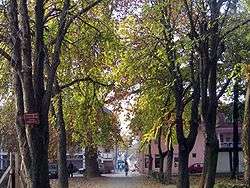Šamac, Bosnia and Herzegovina
| Šamac Шамац | |
|---|---|
| Town and municipality | |
 | |
 Location of Šamac within Republika Srpska | |
| Coordinates: 45°04′N 18°28′E / 45.067°N 18.467°ECoordinates: 45°04′N 18°28′E / 45.067°N 18.467°E | |
| Country | Bosnia and Herzegovina |
| Entity | Republika Srpska |
| Government | |
| • Mayor | Savo Minić (SNSD) [1] |
| • Municipality | 177.54 km2 (68.55 sq mi) |
| Population (2013 census) | |
| • Town | 5,390 |
| • Municipality | 17,273 |
| • Municipality density | 97/km2 (250/sq mi) |
| Time zone | UTC+1 (CET) |
| • Summer (DST) | UTC+2 (CEST) |
| Area code(s) | 54 |
| Website |
www |
Šamac (Serbian Cyrillic: Шамац, pronounced [ʃâmat͡s])[2] is a town and municipality located in the northeastern part of the Republika Srpska, an entity of Bosnia and Herzegovina. As of 2013, the town has a population of 5,390 inhabitants, while the municipality has 17,273 inhabitants.
It is situated on the right bank of the Sava river. Across the river is Slavonski Šamac in Croatia.
History
The city was founded by Bosnian settlers from Ottoman province of Smederevo in 1862. It was part of the Ottoman province of Bosnia by the time it was annexed by Austro-Hungarian Empire in 1887. After World War I, the city became part of the Kingdom of Yugoslavia. From 1929 to 1939, it was part of Drina Banovina; and from 1939 until 1941 it was part of the Banovina of Croatia. During World War II, Šamac, as all the rest of Bosnia-Herzegovina, was included into Nazi-controlled Independent State of Croatia. After 1945, the city was reintegrated within the Socialist Republic of Bosnia and Herzegovina in Tito's Yugoslavia.
In the early stages of the Bosnian war the town was occupied by Bosnian Serbs who established the provisional municipal government. Most Bosniaks and Bosnian Croats were ethnically cleansed.[3][4] During the war, a semi-permanent front line was established against Croatian and Bosniak forces towards the neighboring Orašje. In 2003, three Bosnian Serb town leaders at the time of the Yugoslav Wars were sentenced in ICTY for crimes against humanity.[5]
The town lies on an important strategic position in Republika Srpska, near Brčko. As with most other places under Serb control, Srpska authorities removed the "Bosnian" adjective from the town's official name and changed it to "Šamac". Bosniaks and Bosnian Croats continued to refer to it by its historical name of "Bosanski Šamac" (Serbian Cyrillic: Босански Шамац, pronounced [bǒsanskiː ʃâmat͡s])[2] causing tension among the inhabitants. A court order had the official name changed to simply Šamac removing any ethnic divisions in its previous names.
Demographics
| Historical population | ||
|---|---|---|
| Year | Pop. | ±% p.a. |
| 1948 | 37,512 | — |
| 1953 | 44,269 | +3.37% |
| 1971 | 31,374 | −1.89% |
| 1981 | 32,320 | +0.30% |
| 1991 | 32,960 | +0.20% |
| 2013 | 17,273 | −2.89% |
According to the 2013 census results, the municipality of Šamac has 17,273 inhabitants.
Ethnic groups
The ethnic composition of the municipality:
| Ethnic group | Population 1971 |
Population 1991 |
Population 2013[6] |
|---|---|---|---|
| Serbs | 14,230 | 13,628 | 13,256 |
| Croats | 14,336 | 14,731 | 2,426 |
| Bosniaks/Muslims | 2,192 | 2,233 | 1,265 |
| Yugoslavs | 481 | 1,755 | - |
| Others | 135 | 613 | 326 |
| Total | 31,374 | 32,960 | 17,273 |
Settlements
Aside from the town of Šamac, the municipality includes the following settlements:
- Batkuša
- Bazik
- Brvnik
- Crkvina
- Domaljevac
- Donja Slatina
- Donji Hasić
- Gajevi
- Gornja Slatina
- Gornji Hasić
- Grebnice
- Kornica
- Kruškovo Polje
- Novo Selo
- Obudovac
- Pisari
- Prud
- Srednja Slatina
- Škarić
- Tišina
- Zasavica
- Tursinovac
Sport
The local football club, FK Borac Šamac, plays in the First League of the Republika Srpska.
Gallery
- Main square
- Monument to Serb casualties of the Bosnian War
Notable people
- Alija Izetbegović, first President of Bosnia and Herzegovina
- Darijo Srna, footballer
- Mario Mandžukić, footballer
- Ljubo Miloš (1919–1948), Croatian World War II official and concentration camp commandant executed for war crimes
- Predrag Nikolić, chess Grand Master
- Stevo Nikolić, footballer
- Srebrenko Repčić, former football player
- Sulejman Tihić, Bosniak member of the Presidency of Bosnia and Herzegovina
- Zoran Đinđić, former prime minister of Serbia
See also
Notes
- ↑ From Centralna izborna komisija Bosne i Hercegovine Archived 2006-12-21 at the Wayback Machine. — in Serbo-Croatian
- 1 2 Mangold (2005:212)
- ↑ War Crimes in Bosnia-Hercegovina: Bosanski Samac — Six War Criminals Named by Victims of “Ethnic Cleansing”, Human Rights Watch, April 1994
- ↑ FACE TO FACE WITH EVIL, Time magazine, May 13, 1996
- ↑ International Criminal Tribunal for the Former Yugoslavia (ICTY) (Trial Chamber II): Prosecutor v. Blagoje Simic, Mirolsav Tadic and Simo Zadic (October 17, 2003) Archived February 6, 2012, at the Wayback Machine.
- ↑ "POPIS STANOVNIŠTVA, DOMAĆINSTAVA I STANOVA U BOSNI I HERCEGOVINI, 2013. REZULTATI POPISA" (PDF). popis2013.ba (in Serbian). Retrieved 15 December 2016.
References
- Official results from the book: Ethnic composition of Bosnia-Herzegovina population, by municipalities and settlements, 1991. census, Zavod za statistiku Bosne i Hercegovine - Bilten no.234, Sarajevo 1991.
- Mangold, Max (2005), Das Aussprachewörterbuch, Duden, ISBN 9783411040667
External links
| Wikimedia Commons has media related to Šamac. |